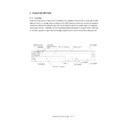Sharp AR-810 (serv.man10) Service Manual ▷ View online
AR-651/810 SCANNING SECTION 6 - 5
6. 3. 2. Two-phase motor drive circuit (fixed-current type)
The scanner motor is driven by the unipolar transistors as shown below. The current chopper method is
employed by the driver circuit to improve motor torque STK672-080 (IC4).
15
14
13
12
11
10
9
8
6
7
ENABLE
Mol
RESET
M3
CLOCK
CWB
M2
M1
Vcc2
Vref
A
A
B
B
BB
PG
SUB
5
4
3
2
1
Excitation
mode setting
Switching pulse
ON/OFF detection
Excitation
status monitor
CR oscillation
Phase
counter
Generation of
reference clock
PWM control
Generation of phase
excitation signal
Generation
of pseudo
sine wave
Switching
current
fraction ratio
AR-651/810 SCANNING SECTION 6 - 6
SCN-MOT
PWA-F-SLG
1
2
3
4
5
6
6
5
4
3
2
1
IC4
IC9
J8
SCNEN-0
SCNDIR-0
SCNRST
SCNREF-0A
SCNMD3-0
SCNMD2-0
SCNMD1-0
SCNCLK-0
1
2
3
4
J9
+36V
+36V
Circuit diagram
Scanner CPU
Motor
driver
The motor is rotated by setting the number of pulses.
* The internal circuit of the motor driver works at the rising and falling
edge of the pulse.
The direction of the motor rotation is determined by the setting level
of the signal
“H”…Clockwise direction (as seen from the output shaft)
“L”…Counterclockwise direction (as seen from the output shaft)
Note: When SCNMD3-0 is “L”, do not change the rotation direction
within 6.25µs before and after the rising and falling edge of
the pulse of SCNCLK-0.
“H” …Normal operation (The motor has been excited.)
“L”…Excitation drive output is forcibly shut OFF (the motor has not
been excited).
Motor wire current value is set in the range of 0 to 2.25 (A)/phase by
applying the analog voltage 0 to 5 (V).
Sets the excitation mode.
Note: Do not change the setting
within
5µs before and after the
rising and falling edge of the pulse of SCNCLK-0.
Internal circuit of the driver is initialized by setting the motor to “L”
level (pulse interval: 10µs or more).
The motor drive circuit is automatically reset when the power is
turned ON.
SCNCLK-0
CLK input
Input
SCNDIR-0
Sets the direction
Input
of motor rotation
SCNEN-0
Cuts OFF the
Input
drive output
SCNREF-0A
Voltage to set value
Input
for the motor current
SCNMD1~3-0 Sets the
excitation
Input
mode (1)–(3)
SCNRST
Reset
Input
Input signals
AR-651/810 SCANNING SECTION 6 - 7
6. 4. Control for Exposure Lamp
6. 4. 1. General description
Control circuit of the exposure lamp consists of the following 3 blocks.
(1) Lighting device for the Xenon lamp (Inverter)
Turns the exposure lamp ON/OFF.
(2) CCD sensor circuit
This circuit works to the convert the reflected light amount from the original surface and the shading
correction plate to the electrical signals. The reflected light amount from the shading correction plate is
read to control the exposure amount.
(3) Image processing circuit
The output signals from the CCD are digitized and the image processing such as gamma correction
and shading correction is applied to them.
PWA-CCD
PWA-CCD
Image processing
circuit
circuit
A/D
PWA-SLG
Main CPU
IC37
Construction of exposure lamp control circuit
Original
Shading correction plate
Exposure lamp (Xenon lamp)
CCD sensor
Lighting device
for Xenon lamp
for Xenon lamp
(Inverter)
Scanner
CPU
AR-651/810 SCANNING SECTION 6 - 8
6. 4. 2. Exposure lamp
External electrode type Xenon fluorescent lamp is used as an exposure lamp in this copier.
(1) Structure
The fluorescer is applied to the in-
side surface of the lamp pipe (ex-
cept for a part which serves as an
opening) which is filled with the Xe-
non gas.
A pair of the external electrodes
covered by film with adhesive agent
is attached around the pipe.
(2) Behavior inside the lamp
The electron inside the pipe is led
to the electric field by applying volt-
age to the pair of the external elec-
trodes, and the discharge is started.
The electrons then flow and clash
with the Xenon atoms inside the pipe
to excite them and allow them to
generate ultraviolet rays. This ultra-
violet rays convert the fluorescer into
visible light.
(1)Electrode (2)Electron (3)Xenon atom (4)Ultraviolet ray (5)Fluorescer
(6)Visible light (irradiated from the opening to outside the pipe)
(7)Opening (8)Harness
(6)Visible light (irradiated from the opening to outside the pipe)
(7)Opening (8)Harness
PET film
Aluminum tape
electrode
electrode
Adhesive agent
Glass valve
Fluorescer
Xenon gas
(1)
(6)
(8)
(7)
(5)
(2)
(4)
(3)
Click on the first or last page to see other AR-810 (serv.man10) service manuals if exist.

